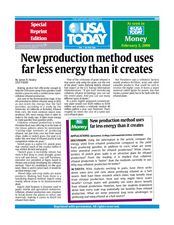Curated OER
Will Biotech Crops Solve World Problems?
Pupils read an online article to examine what biotechnology and agricultural biotechnology are. They answer questions and complete worksheets based on the article's information.
Curated OER
Corn-Crop is a Bin-Buster
Learners calculate percent change and create lists of data. They enter the corresponding bushels of corn measured in billions to their list and display, then convert the acres into scientific notation and use the value on the home screen...
Curated OER
New Production Method Uses Far Less Energy Than It Creates
Twelfth graders explore the usage of alcohol fuel. In this Current Events instructional activity, 12th graders research the issue of using this type of energy. Students complete a worksheet on their research.
Curated OER
Filling Up-Gasoline
In this fuel sources worksheet, students calculate the E85 alternative fuel costs per gallon compared to the cost of gasoline. Students complete a table to show the comparison prices. They create a triple line graph to show the...
Curated OER
Map Skills
Students create two types of maps. In this map skills lesson, students discuss map vocabulary and view maps of Florida. Students draw a free hand map of Florida and include major cities, bodies of water and land forms. Students work...
Curated OER
Breaking News English: The Mystery of America's Vanishing Bees
In this English worksheet, students read "The Mystery of America's Vanishing Bees," and then respond to 47 fill in the blank, 7 short answer, 20 matching, and 8 true or false questions about the selection.
Texas Instruments
Texas Instruments: Science Today 2004 Corn Crop Is a Bin Buster
With this resource, students will examine and evaluate data on the corn harvest in the United States over the past several years. Using the USA TODAY Snapshot "2004 corn crop is a bin-buster," data from the USDA Statistics Service...
University of Groningen
American History: Essays: Anglo Amer. Colonization in Texas: Food Production
Describes the role Texas played in trading food crops in the mid-1800s.









